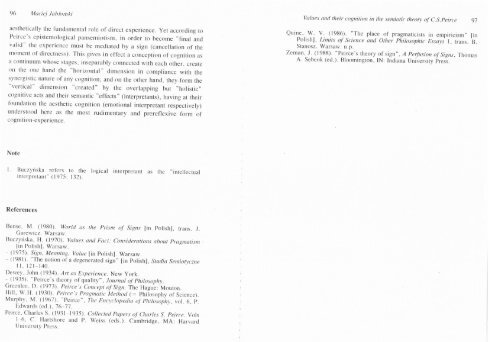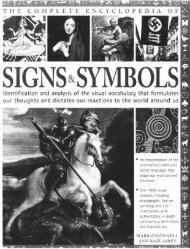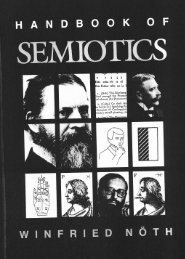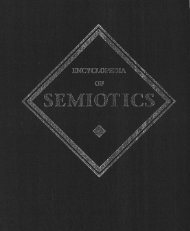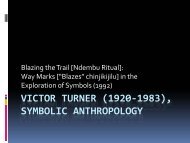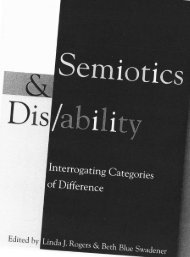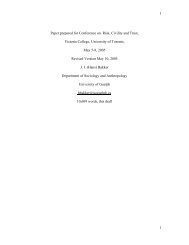Musical Semiotics in Growth - SemioticSigns.com
Musical Semiotics in Growth - SemioticSigns.com
Musical Semiotics in Growth - SemioticSigns.com
You also want an ePaper? Increase the reach of your titles
YUMPU automatically turns print PDFs into web optimized ePapers that Google loves.
96 Maciej Jabloiski<br />
aesthetically the fundarnental role of direct experience. yet accord<strong>in</strong>g to<br />
Peirce's epistemological pansemiotism, <strong>in</strong> order to be<strong>com</strong>e "f<strong>in</strong>al and<br />
valid" the experience must be mediatecl by a sigrr (cancellation of the<br />
nx)ment of dircctness). This gives <strong>in</strong> eft'ect a c()nception of cognition as<br />
a cont<strong>in</strong>uum whose stages, <strong>in</strong>separably co'nected with each other. create<br />
.n the one hand the "horizontal" tlimension <strong>in</strong> <strong>com</strong>pliance with the<br />
syncrgistic nature of any cognition: and on the other hand, they.form the<br />
"vertical" dimension "createcl" by the overlapp<strong>in</strong>g but "holistic,'<br />
Values and tlteir cognition <strong>in</strong> the serniotic theory of C.S.peirce 97<br />
Qu<strong>in</strong>e, W. V. (1986)._"The place of pragmaticisrs <strong>in</strong> empiricism,' [<strong>in</strong><br />
Polishl, Limits of science and other philosophic Essayi r, rrans. B.<br />
Stanosz. Warsaw: n.o.<br />
zeman, J. (1988)."Peirce's theory of sign". ,4 perfusiott of signs, Thomas<br />
A. Sebeok (ed.). Bloom<strong>in</strong>gton, IN: Indiana L/niversity ijr.rr.<br />
cognitive acts and their semantic "effects" (<strong>in</strong>terpretants), hav<strong>in</strong>g at their<br />
tirundation the aesthetic cognition (emotional <strong>in</strong>terpretant respectively)<br />
understood lrere as the nrost ruclimentary and prereflexive form of<br />
cogn i tiorr-experience.<br />
Note<br />
L<br />
Buczynska re{ers to the<br />
rnterpretant" ( 1975. | 32\.<br />
logical <strong>in</strong>terprerant as the "<strong>in</strong>tellectual<br />
Refe rences<br />
Bense. M. (1980). World as the prism of Silns l<strong>in</strong> polishl, rrans. .f.<br />
Garcwicz. Warsaw<br />
Bucz-yriska, H. (1970). Vttlue.s and Fac't; Considerations about pragma.ttsm<br />
l<strong>in</strong> Polishl. Warsaw.<br />
- (1975). Sign, Mean<strong>in</strong>g, Vcrlue l<strong>in</strong> polish]. Warsaw.<br />
- (198 l). "The notion of a degenerated sign" [<strong>in</strong> polish], studia semioryczn.e<br />
t1. t2t-140.<br />
Dewey, John (1934). Art as Ex.pericrce. New york.<br />
(193-5). "Peirce's theory of quality" , Journal of philosophy.<br />
Greenlee. D. (1973). Peirce's Concept o.f Sign. The Hagr.,'Mnuton.<br />
Llill. W.t{. (1930). Peirce's pragmatic Merhotl (: philosophy of Science).<br />
Murph1,. M. (1967)."Peirce", Tlrc Enct,r'lopedia of phitoiophy, vol.6. p.<br />
Ildwards (ed.).76-77.<br />
Peirce, Charles S. (1931-1935). Collected papers of Cltctrles S. pejrce. Vols<br />
I 6. C. Harrshore ancl p. Weiss (eds.). C<strong>in</strong>rbridge. MA: Harvard<br />
tlniversity Press.


